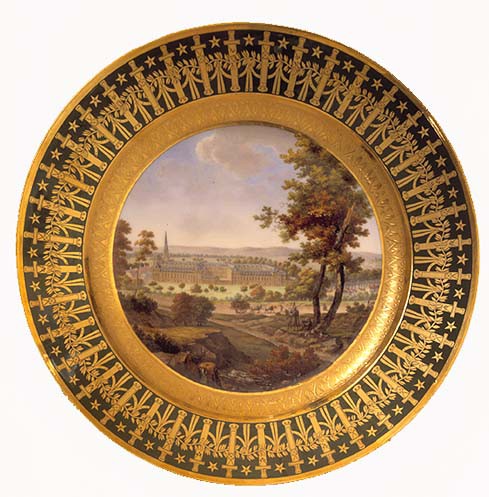In 1807, Napoleon ordered from the Sèvres manufactory a service for his own personal use, the “Service particulier de l'Empereur”. This famous service, better known as the “Headquarters” service, is remarkable not only for its quality and beauty but also for the role which Napoleon played in making it. Indeed, the Emperor gave precise instructions as to the subjects to be painted on the plates, as revealed in a letter from Daru to the director of the Sèvres manufactory, Alexandre Brongniart: “…his intention is that none of the plates should bear images of battles or names of men. Quite the opposite. The subjects should only be very indirect and allusive, evoking pleasant memories“. For Napoleon, the pleasant memories were mostly the battlefields of Italy, Egypt, Austria, Prussia and Poland. Napoleon provided an initial list of 28 subjects, which was completed by Brongniart and Denon with the addition of views of palaces, towns and landscapes, construction work, museums and monuments in Paris, as well as the major imperial institutions, such as here, the Prytanée de Saint-Cyr. On 27 March, 1810, the service was finally delivered to the Tuileries, just in time to provide the table decoration for the high imperial table for the marriage of Napoleon and Marie-Louise seven days later. Costing about 70,000 Francs of the period, the service comprises three main elements: an 'entrée' (maincourse) and dessert section (178 items including 72 dessert plates), a table centrepiece in biscuit (25 pieces), a coffee service (25 items). The dessert plates are all identically composed, namely: a “green chrome” surround decorated with radiating daggers in dark gold, with a central painted scene.
This service went with Napoleon to Saint Helena, where according to Marchand, it continued to bring admiration to the Emperor and happiness to his companions in exile, who received pieces of the service as presents. The inventory drawn up on the Emperor's death noted the presence of “54 porcelain Sèvres dessert plates”. The will stipulated: “…I charge Comte de Montholon with the task of keeping these objects and of giving them to my son when he is sixteen years old … “. Because the Austrian Court refused the bequest, the service remained in the Montholon family and was later dispersed. Today, two large collections of this service have survived, one is held at the Musée de Fontainebleau, and the other in the Collection Martial Lapeyre of the Fondation Napoléon.
This piece can be seen at the exhibition “Napoléon-Wellington: Destins Croisés” at the Wellington Museum, Waterloo, Belgium [21/03/2015 – 31/07/2015]
Karine Huguenaud (tr. P.H.)
June 2002
This object is one of the masterpieces of the Fondation Napoléon's collection, which you can learn more about here.
Dessert plate from the «Service particulier de l’Empereur» : "Le prytanée de Saint-Cyr" by N.-A. Lebel

- Date :
- 1808
- Technique :
- porcelain
- Dimensions :
- Diam. = 0.237 m
- Place held :
- Fondation Napoléon, donation Martial Lapeyre
- Photo credit :
- Fondation Napoléon

